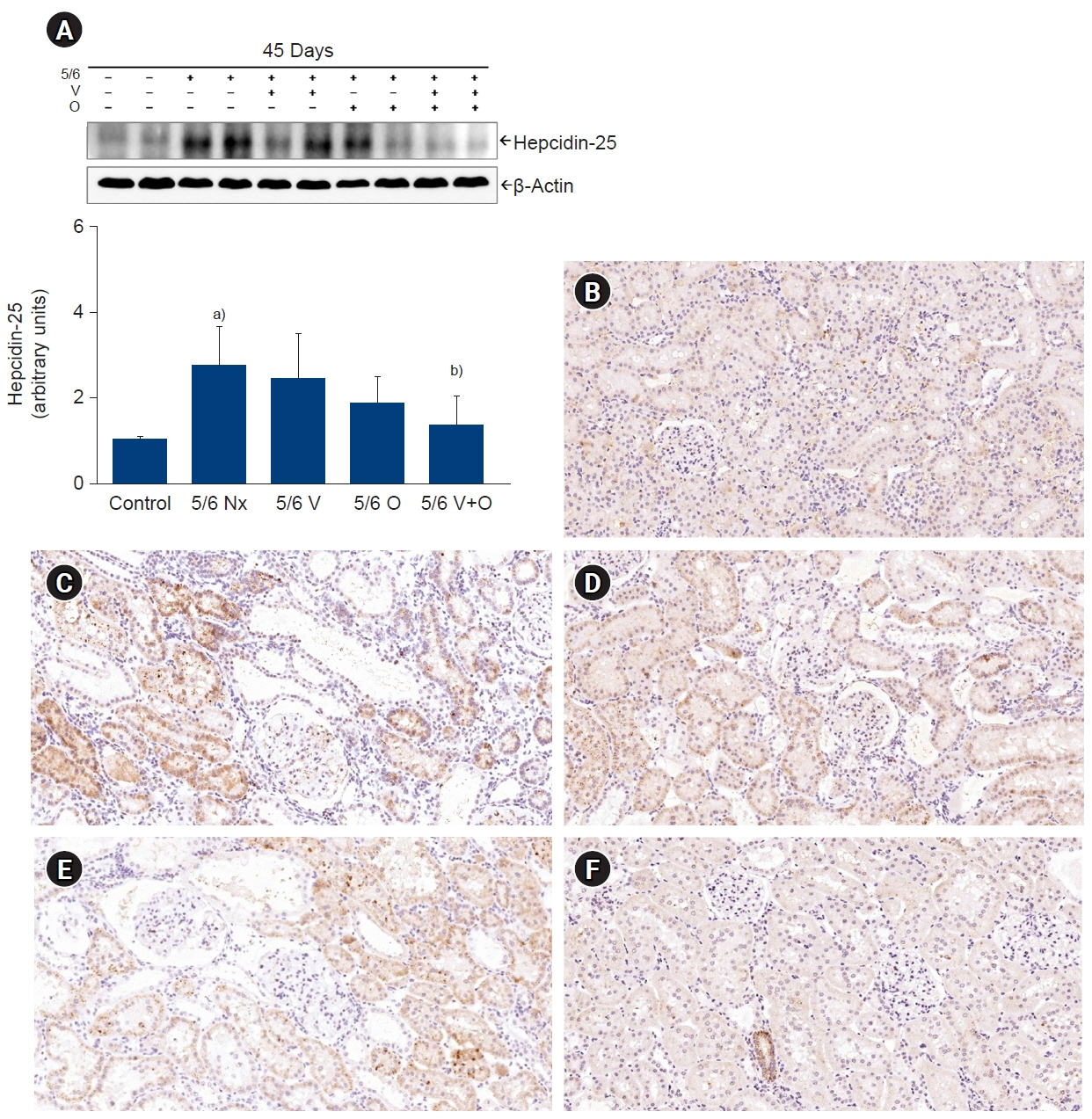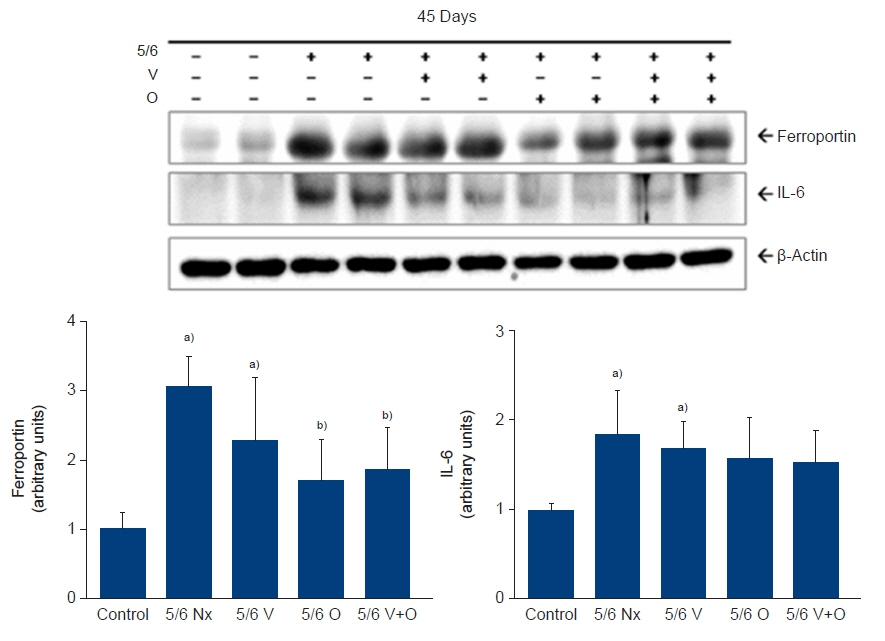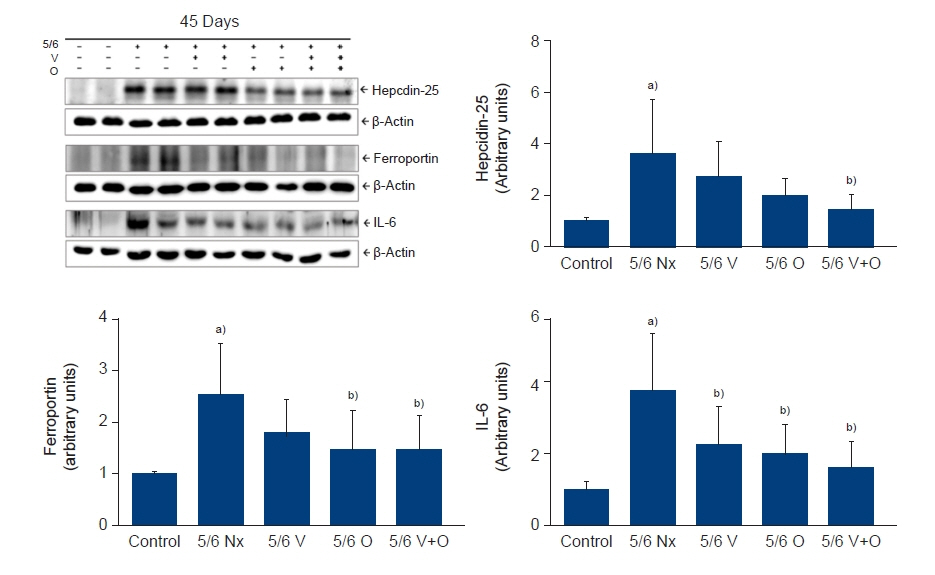Kosin Med J.
2024 Mar;39(1):35-43. 10.7180/kmj.23.137.
Effects of cholecalciferol and omega-3 fatty acids on hepcidin levels in 5/6 nephrectomy rats
- Affiliations
-
- 1Department of Internal Medicine, Dong-A University College of Medicine, Busan, Korea
- 2Department of Anatomy and Cell Biology, Dong-A University, Busan, Korea
- 3Medical Science Research Center, Dong-A University, Busan, Korea
- KMID: 2556796
- DOI: http://doi.org/10.7180/kmj.23.137
Abstract
- Background
Anemia is a common complication of chronic kidney disease (CKD). In patients with CKD-related anemia, an inverse relationship between vitamin D and hepcidin levels has been observed. Hepcidin is a key regulator of iron homeostasis, mediated via binding to ferroportin. The aim of this study was to investigate the effects of cholecalciferol and omega-3 fatty acids (FA) on hepcidin levels using 5/6 nephrectomized (Nx) rats.
Methods
Male Sprague-Dawley rats were divided into five groups: sham control, 5/6 Nx, 5/6 Nx treated with cholecalciferol, 5/6 Nx treated with omega-3 FA, and 5/6 Nx treated with both cholecalciferol and omega-3 FA. We measured the hepcidin and ferroportin levels in the kidney and liver by enzyme-linked immunosorbent assays and Western blots. We evaluated hepcidin expression in the kidney by immunohistochemical staining.
Results
Among the five groups, 5/6 Nx rats exhibited the worst kidney function. Compared with the sham controls, 5/6 Nx rats showed significantly increased serum hepcidin levels and decreased vitamin D levels. Supplementation with either omega-3 FA or cholecalciferol decreased hepcidin and increased vitamin D levels, with a concurrent improvement of anemia. Furthermore, 5/6 Nx rats treated with omega-3 FA/cholecalciferol showed decreased ferroportin and ferritin levels, while iron and total iron-binding capacity levels increased.
Conclusions
Treatment with a combination of cholecalciferol and omega-3 FA may improve anemia in a CKD rat model by decreasing hepcidin levels.
Figure
Reference
-
References
1. Stauffer ME, Fan T. Prevalence of anemia in chronic kidney disease in the United States. PLoS One. 2014; 9:e84943.2. Levin A, Stevens PE, Bilous RW, Coresh J, De Francisco ALM, De Jong PE, et al. Kidney Disease: Improving Global Outcomes (KDIGO) CKD Work Group. KDIGO 2012 clinical practice guideline for the evaluation and management of chronic kidney disease. Kidney Int Suppl. 2013; 3:1–150.3. Finkelstein FO, Story K, Firanek C, Mendelssohn D, Barre P, Takano T, et al. Health-related quality of life and hemoglobin levels in chronic kidney disease patients. Clin J Am Soc Nephrol. 2009; 4:33–8.4. Spinowitz B, Pecoits-Filho R, Winkelmayer WC, Pergola PE, Rochette S, Thompson-Leduc P, et al. Economic and quality of life burden of anemia on patients with CKD on dialysis: a systematic review. J Med Econ. 2019; 22:593–604.5. Gouva C, Nikolopoulos P, Ioannidis JP, Siamopoulos KC. Treating anemia early in renal failure patients slows the decline of renal function: a randomized controlled trial. Kidney Int. 2004; 66:753–60.6. Rao M, Pereira BJ. Optimal anemia management reduces cardiovascular morbidity, mortality, and costs in chronic kidney disease. Kidney Int. 2005; 68:1432–8.7. National Kidney Foundation. KDOQI Clinical Practice Guidelines and Clinical Practice Recommendations for Anemia in Chronic Kidney Disease. Am J Kidney Dis. 2006; 47(5 Suppl 3):S11–145.8. Kendrick J, Targher G, Smits G, Chonchol M. 25-Hydroxyvitamin D deficiency and inflammation and their association with hemoglobin levels in chronic kidney disease. Am J Nephrol. 2009; 30:64–72.9. Patel NM, Gutierrez OM, Andress DL, Coyne DW, Levin A, Wolf M. Vitamin D deficiency and anemia in early chronic kidney disease. Kidney Int. 2010; 77:715–20.10. Kiss Z, Ambrus C, Almasi C, Berta K, Deak G, Horonyi P, et al. Serum 25(OH)-cholecalciferol concentration is associated with hemoglobin level and erythropoietin resistance in patients on maintenance hemodialysis. Nephron Clin Pract. 2011; 117:373–8.11. Nemeth E, Tuttle MS, Powelson J, Vaughn MB, Donovan A, Ward DM, et al. Hepcidin regulates cellular iron efflux by binding to ferroportin and inducing its internalization. Science. 2004; 306:2090–3.12. Mercadal L, Metzger M, Haymann JP, Thervet E, Boffa JJ, Flamant M, et al. The relation of hepcidin to iron disorders, inflammation and hemoglobin in chronic kidney disease. PLoS One. 2014; 9:e99781.13. Bacchetta J, Zaritsky JJ, Sea JL, Chun RF, Lisse TS, Zavala K, et al. Suppression of iron-regulatory hepcidin by vitamin D. J Am Soc Nephrol. 2014; 25:564–72.14. An WS, Lee SM, Son YK, Kim SE, Kim KH, Han JY, et al. Effect of omega-3 fatty acids on the modification of erythrocyte membrane fatty acid content including oleic acid in peritoneal dialysis patients. Prostaglandins Leukot Essent Fatty Acids. 2012; 86:29–34.15. Sidiartha IG, Bakta IM, Wiryana IM, Sutirtayasa IW, Sjarif DR. Eicosapentaenoic acid and docosahexaenoic acid in fish oil capsule supplementation in obese children decreases serum interleukin-6 and hepcidin and improves iron status. Bali Med J. 2017; 6:97–101.16. Lee SM, Lee MH, Son YK, Kim SE, An WS. Combined treatment with omega-3 fatty acid and cholecalciferol increases 1,25-dihydroxyvitamin d levels by modulating dysregulation of vitamin D metabolism in 5/6 nephrectomy rats. Nutrients. 2019; 11:2903.17. An WS, Kim HJ, Cho KH, Vaziri ND. Omega-3 fatty acid supplementation attenuates oxidative stress, inflammation, and tubulointerstitial fibrosis in the remnant kidney. Am J Physiol Renal Physiol. 2009; 297:F895–903.18. Schmidt PJ. Regulation of iron metabolism by hepcidin under conditions of inflammation. J Biol Chem. 2015; 290:18975–83.19. Ashby DR, Gale DP, Busbridge M, Murphy KG, Duncan ND, Cairns TD, et al. Erythropoietin administration in humans causes a marked and prolonged reduction in circulating hepcidin. Haematologica. 2010; 95:505–8.20. Yilmaz MI, Solak Y, Covic A, Goldsmith D, Kanbay M. Renal anemia of inflammation: the name is self-explanatory. Blood Purif. 2011; 32:220–5.21. Bowry SK, Gatti E. Impact of hemodialysis therapy on anemia of chronic kidney disease: the potential mechanisms. Blood Purif. 2011; 32:210–9.22. Calton EK, Keane KN, Newsholme P, Soares MJ. The impact of vitamin D levels on inflammatory status: a systematic review of immune cell studies. PLoS One. 2015; 10:e0141770.23. Verga Falzacappa MV, Vujic Spasic M, Kessler R, Stolte J, Hentze MW, Muckenthaler MU. STAT3 mediates hepatic hepcidin expression and its inflammatory stimulation. Blood. 2007; 109:353–8.24. Tabibi H, Mirfatahi M, Hedayati M, Nasrollahi A. Effects of flaxseed oil on blood hepcidin and hematologic factors in hemodialysis patients. Hemodial Int. 2017; 21:549–56.25. Garrido P, Ribeiro S, Fernandes J, Vala H, Bronze-da-Rocha E, Rocha-Pereira P, et al. Iron-hepcidin dysmetabolism, anemia and renal hypoxia, inflammation and fibrosis in the remnant kidney rat model. PLoS One. 2015; 10:e0124048.26. Hamada Y, Kono TN, Moriguchi Y, Higuchi M, Fukagawa M. Alteration of mRNA expression of molecules related to iron metabolism in adenine-induced renal failure rats: a possible mechanism of iron deficiency in chronic kidney disease patients on treatment. Nephrol Dial Transplant. 2008; 23:1886–91.27. van Swelm RP, Wetzels JF, Verweij VG, Laarakkers CM, Pertijs JC, van der Wijst J, et al. Renal handling of circulating and renal-synthesized hepcidin and its protective effects against hemoglobin-mediated kidney injury. J Am Soc Nephrol. 2016; 27:2720–32.28. Lac PT, Choi K, Liu IA, Meguerditchian S, Rasgon SA, Sim JJ. The effects of changing vitamin D levels on anemia in chronic kidney disease patients: a retrospective cohort review. Clin Nephrol. 2010; 74:25–32.29. Icardi A, Paoletti E, De Nicola L, Mazzaferro S, Russo R, Cozzolino M. Renal anaemia and EPO hyporesponsiveness associated with vitamin D deficiency: the potential role of inflammation. Nephrol Dial Transplant. 2013; 28:1672–9.30. Zughaier SM, Alvarez JA, Sloan JH, Konrad RJ, Tangpricha V. The role of vitamin D in regulating the iron-hepcidin-ferroportin axis in monocytes. J Clin Transl Endocrinol. 2014; 1:19–25.31. Pistis KD, Westerberg PA, Qureshi AR, Beshara S, Sterner G, Barany P, et al. The effect of high-dose vitamin D supplementation on hepcidin-25 and erythropoiesis in patients with chronic kidney disease. BMC Nephrol. 2023; 24:20.32. Panwar B, McCann D, Olbina G, Westerman M, Gutierrez OM. Effect of calcitriol on serum hepcidin in individuals with chronic kidney disease: a randomized controlled trial. BMC Nephrol. 2018; 19:35.33. Obi Y, Yamaguchi S, Hamano T, Sakaguchi Y, Shimomura A, Namba-Hamano T, et al. Effect of cholecalciferol on serum hepcidin and parameters of anaemia and CKD-MBD among haemodialysis patients: a randomized clinical trial. Sci Rep. 2020; 10:15500.
- Full Text Links
- Actions
-
Cited
- CITED
-
- Close
- Share
- Similar articles
-
- Letter to the Editor: Effects of Omega-3 Fatty Acids on Erectile Dysfunction in a Rat Model of Atherosclerosis-induced Chronic Pelvic Ischemia
- Omega-3 Index as a Risk Factor for Cardiovascular Disease and Its Application to Korean Population
- Omega-3 and Menopause
- Effects of omega-3 fatty acids, vitamins, and chelation therapy in patients with heart diseases
- Supplementary nutrients for prevention of vascular calcification in patients with chronic kidney disease




